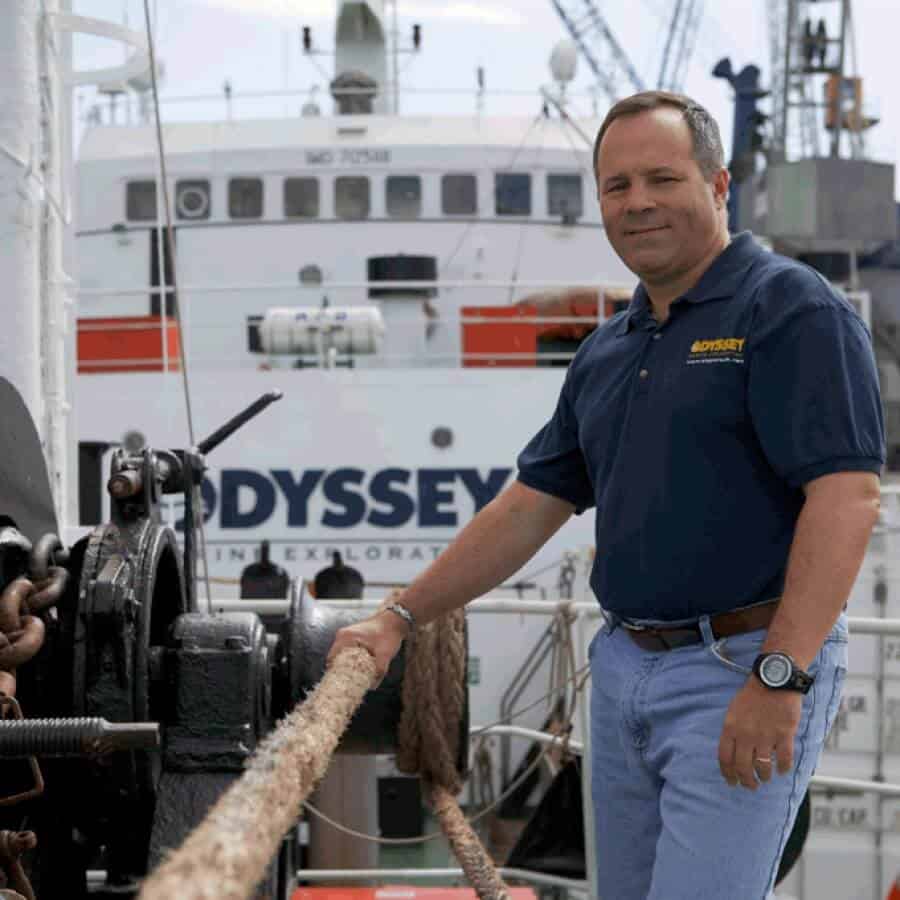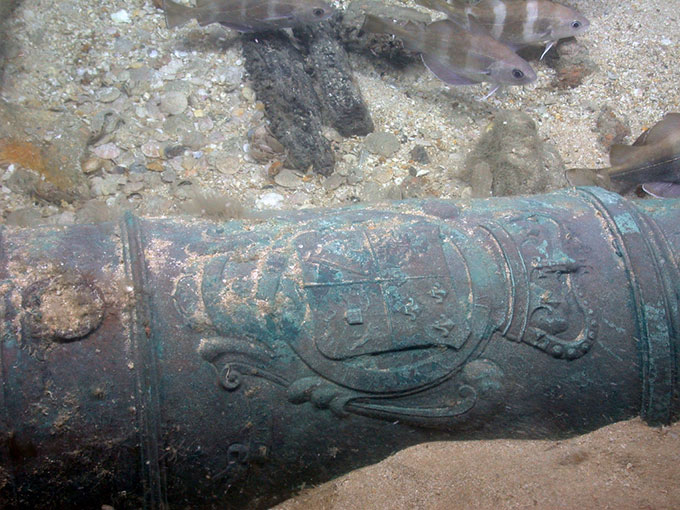TREASURE – The very word evokes a feeling of adventure and legend. Scientists, anthropologists, and governments are as enamored with deep sea treasures as the average person. Odyssey Marine Exploration, founded in 1994 and listed on the NASDAQ, is an organization that comprises professionals, scientists, and technicians and is dedicated to underwater and deep sea exploration of treasure and minerals. We have the opportunity to interview their CEO, Mark Gordon.
Mr. Gordon, your bio is what stories are made of. Business management, MBA in Finance, entreprenuer, and a shipwreck diver. Please tell us about your journey to your present position and how many shipwreck dives you have personally made?
Thank you for the opportunity to share my story with your readers!
Ever since I was a child growing up in New Jersey, I was fascinated with the ocean. I spent a lot of time at the beach exploring the coastline and wondering what was lying far below the waves. While in college at American University working towards my MBA, I worked as a shipwreck diver and instructor for the National Diving Center in Washington, DC. From 1979 through 1993, I completed hundreds of dives on shipwrecks off the East Coast of the United States, from New York down to North Carolina. A particularly exciting memory during this time was being the first person to discover and dive on the SS Proteus, a ship that had been missing since the early 1900s.
After leaving the dive business, I owned and managed four different start-up ventures in the technology industry, which culminated in selling my last one, Synergy Networks, to the Rockefeller Group in 2003. Shortly after that, my long-time friend Greg Stemm, Odyssey’s co-founder, contacted me to help mobilize the company‘s new 251-foot deep-ocean archaeological recovery vessel, the Odyssey Explorer.
Before you joined Odyssey Marine, you founded Synergy Networks, which you sold to the Rockefeller Group. Please tell us a little about that and your motivation to move to Odyssey.
My motivation was pretty simple: it was an opportunity to live out my childhood dream of exploring the ocean!
Two weeks to the day after selling my company to the Rockefeller Group, I received an urgent call from my friend Greg Stemm. Greg needed immediate assistance with preparing Odyssey’s new vessel, the Odyssey Explorer, because they had just discovered the SS Republic, a US Civil War-era ship carrying a substantial cargo of coins and other incredible treasures. At the time, all of my technical staff members were on long-term assignments. So two weeks after becoming a Rockefeller Group executive, I found myself in Baltimore Harbor running wires through the ship myself. I officially joined the company as a consultant in 2005. It is a truly special thing to be able to do something you are passionate about and always dreamt of doing.
One of the principles your company was founded upon is that there are billions of dollars worth of treasure on the ocean floors. Please tell us about some of your company’s successful missions.
Our company’s first big find was the SS Republic, a US Civil War-era steamship that sank in a hurricane in 1865. The shipwreck was found in 2003 at a depth of 518 meters. The archaeological excavationof the site revealed over 51,000 gold and silver coins as well as 14,000 artifacts.
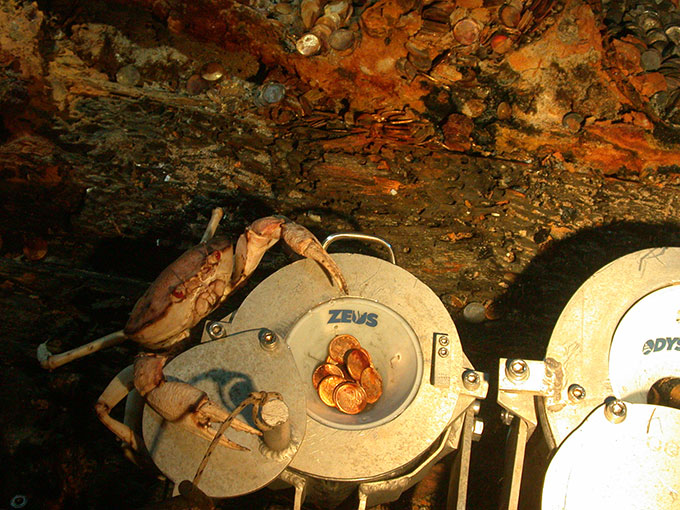
SS Republic Greedy Crab
Odyssey also discovered the long-lost HMS Victory, commanded by Admiral Sir John Balchin. This was the mightiest and most technically advanced vessel of her era. The Victory went down in a severe storm in 1744. Historically, she was the last Royal Navy warship to be lost at sea with a complete complement of bronze cannon. For nearly two centuries, search expeditions had tried to locate the shipwreck, but none had been successful, until we found her in 2008, nearly 100 km away from where she was believed to be resting.
HMS Victory 1744 – Crest on cannon in situ
In 2011, our company discovered the SS Gairsoppa, a World War II merchant ship that was torpedeoed by a German U-boat. This ship was in nearly 4,700 meters of water, which is about half a mile deeper than the Titanic. From that ship we recovered over 110 tons of silver bullion, which set a world record at the time for the deepest and heaviest recovery of valuable cargo from a shipwreck.
While gold and silver treasures tend to garner most of the attention, we have also discovered many other shipwrecks ranging from ancient Roman and Phoenician shipwrecks to German U-boats. From a site in the English Channel, we recovered what may be the oldest carpenter’s rule in existence using a logarithmic scale.
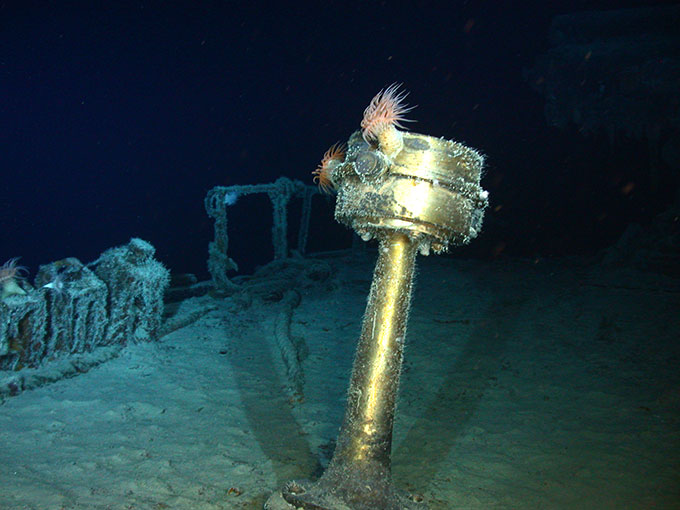
Gairsoppa stern steering pedestal
What is your major focus? Discovering deposits of minerals or exploring for shipwrecks?
The discovery, development, and extraction of deep-ocean minerals is our company’s core focus. We also leverage our deep-ocean expertise in other applications including shipwreck exploration.
Have you been retained by governments for purely cultural reasons?
Most governments don’t have the funds necessary to contract with firms like Odyssey to conduct purely cultural work on deep-ocean shipwrecks, where costs for archaeological excavation can run up to $100,000 per day. Odyssey has conducted several projects with governments and non-profit NGOs that have cultural conditions attached. Odyssey is always ready to conduct purely cultural work, hybrid cultural/economic shipwreck work, and deep-ocean mineral exploration and development for governments and NGOs as well as for clients.
What is the technology you employ and have developed for reaching the deep sea floors?
We operate survey, recovery, and ROV equipment that is rated to 6,000 meters depth. Some of the major pieces of technology include side-scan sonar, magnetometer, multibeam sonar, FADE (Ferrous Anomaly Detection Equipment), TSS (Pulse induction sensors), and sub-bottom imaging (SBI).
Our main pieces of equipment include:
- A deep-tow system called ARES – A 6,000-meter-deep tow survey system that allows for the simultaneous collection of multi-beam, side-scan, and sub-bottom profiling data.
- ROV ZEUS – A Heavy Duty WROV equipped with advanced acoustic positioning equipment and survey sensor packages.
- ROV CLIO – A 6,000m ROV configured to perform precision survey work or light work-class ROV intervention tasks.
- ROV-Actuated Tools – This suite of hydraulic cutting tools allows for remote precision cuts to be conducted with surgical accuracy.
Odyssey leases additional advanced robotics when required to reach extreme depths or when working on several projects during the same timeframe.
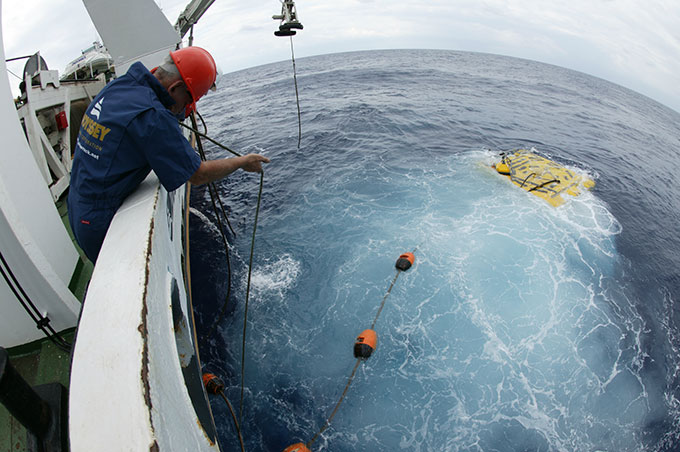
ZEUS recovery
Please tell us about your team.
We reach extreme depths thanks to advances in technology, but the real secret to our success is our team. Our offshore team includes researchers, project managers, ROV pilots, surveyors, geophysicists, subsea engineers, archaeologists, geologists, and scientists from all corners of the globe. Not only do some of the most qualified individuals in the offshore industry work for Odyssey, but more importantly they have been working together as a team for over 10 years on challenges globally – and that is rare!
The marine operations team is supported by a staff on shore that includes legal, IT, accounting/finance, IR, communications, marketing, and business development professionals.
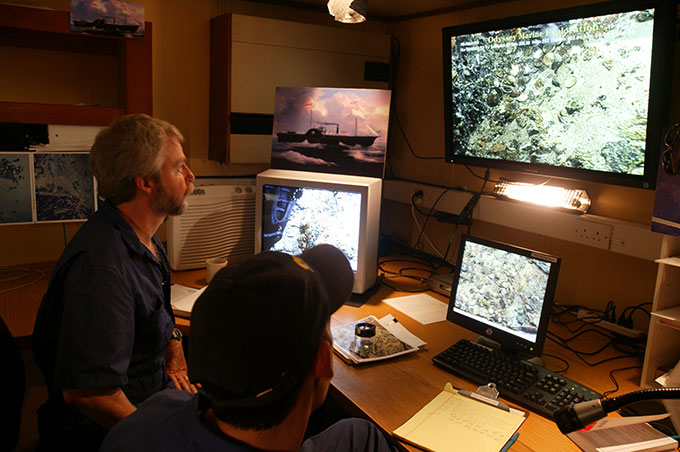
Odyssey Team
Is there an adventurer-scientist in each one of you?
Yes – there is adventure every day at Odyssey, from identifying ways to leverage our core competencies or just keeping the office running smoothly. The work we do goes far beyond gold and silver discovery. The deep-ocean environments we work in offer some incredible marine and scientific discoveries. For instance, on the SS Republic, we were able to recover sand and sediment from the shipwreck site. We discovered a new bacteria that had adapted to survive in the harsh environment 518 meters under the ocean. When we brought it into our normal atmospheric environment this bacteria not only survived, it was able to reproduce – this is extremely rare! Cancer researchers at a major medical institution have been testing the samples we provided them, and they have discovered that this bacteria may in fact be a unique antibiotic. This sample is a protein that can be reproduced, and it is very small, so it shows good potential for ability to penetrate diseased cells. Preliminary tests indicate that this antibiotic seems to kill most known forms of antibiotic-resistant Staph Infections.
Photos: Odyssey Marine Exploration
Support us!
All your donations will be used to pay the magazine’s journalists and to support the ongoing costs of maintaining the site.
Share this post
Interested in co-operating with us?
We are open to co-operation from writers and businesses alike. You can reach us on our email at [email protected]/[email protected] and we will get back to you as quick as we can.
